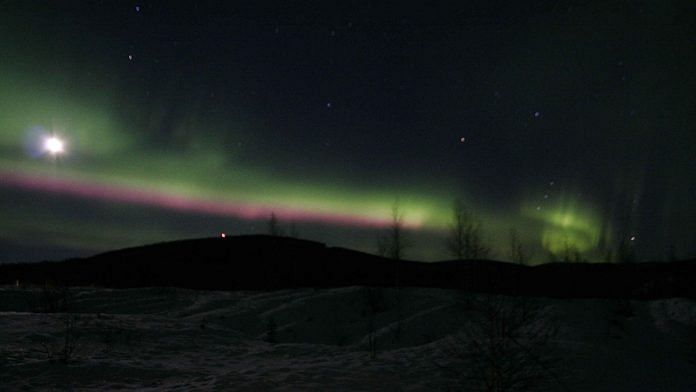Bengaluru: A new BBC Radio 3 documentary has captured the sounds of the northern lights or aurora borealis in Alaska and converted them to music.
The documentary, titled ‘Songs of the Sky’, follows biologist Karin Lehmkuhl Bodony and composer Matthew Burtner into wooded areas, as they travelled away from human settlements and other electrical sources like radio stations and power lines to record the mysterious sounds emitted by the lights without interference.
Bodony, who lives in Alaska’s Galena, discovered many years ago that the interference caused by the northern lights can be recorded using a very low frequency (VLF) receiver.
The sounds were converted to music by Burtner, who works with nature, environmental, and science sounds.
“To hear those ‘whoosh-whoosh’ sounds, which are so like what you see, is really special,” said Bodony in a recent interview.
“There are times when it’s just normal background chattery, crackly sounds and then there’ll be other times when it’s really cool — beautiful whooshing sounds and a chorus that sounds like frogs calling. If it was always the same it wouldn’t be as fun to go out and listen,” she added.
Also read: Jupiter’s icy moon Europa can glow in the dark even with no sun, NASA scientists find
‘Capturing’ the sounds of music
To amplify and improve the quality of recording from the VLF recorder, Burtner used a high quality synthesiser that used the VLF sounds as the input controller.
“You can then alter the timbre of the sound and have the northern lights play different instruments. That let me really orchestrate with the northern lights, using their input as a controller,” he told The Guardian.
VLF receivers operate in the range of 3kHz to 30kHz or from wavelengths of 10km to 100km. The band is used by some radio services, including navigation and military communication. VLF waves can also penetrate water and can be received through clouds.
The musical piece is meant to express the relationship between humans and the natural world.
The documentary further explores traditional interpretations of the northern lights in the Inuit and other Arctic communities, as well as the changing Arctic environment amid rising temperatures.
Also read: There is a ‘natural aerosol factory’ in the Himalayas and it affects climate, study finds
What creates aurorae
The northern lights (and the southern lights, called aurora australis) are caused when electrically charged particles blast out from the sun, in what is called the solar wind, and collide with our upper layers of atmosphere.
When these charged particles interact with the atmosphere, they get excited because of the effect of the Earth’s magnetic field. An atom is said to be excited when electrons in it move to higher energy orbits, farther away from the core nucleus.
When electrons move back to a lower-energy orbit, energy is released in the form of photons or light.
This is similar to how halogen lights work as well, where electricity excites atoms, which emit light.
Aurorae occur in various colours including pink, purple, and white, but is primarily green. The colours depend on the gases that interact with these charged particles. If it’s oxygen, the gases emit a yellow and green colour light. Collisions with nitrogen produce red, violet, and occasionally blue.
They are seen closer to both poles and occur throughout the year. They occur even during daylight but cannot be seen due to the sun. In summer months, due to increased daylight, they are not visible.
“What’s really surprising is that you can hear them at any time of day,” said Burtner
“We tend to think of them happening at night because that’s when we see them but the fact that you didn’t have to be out at night was amazing. We could pull out the VLF recorder at any time and just listen to them through the cloud cover,” he added.
Also read: There’s a 2nd kind of fusion happening in the Sun, scientists confirm through neutrinos



